Onkyo Rubato Dp-s1(B) Ultrahigh Resolution Play Ultra Compact Music Player Reviews
Verdict
Pros
- Sounds first-class
- Wide format support
Cons
- Can't be used as an external DAC
- Limited born retentivity means you lot must get extra cards
- Poor UI
Central Specifications
- Review Price: £399
What is the Onkyo DP-S1
The Onkyo DP-S1 is the entry-level model in Onkyo's portfolio of hi-res digital audio players. It sits just beneath the PD-S10, which boasts a few more gigabytes of potential memory capacity (using micro SD cards) and compatibility with Onkyo Music – the brand's online hi-res music store. Only you lot've got more adventure of spotting a polar bear in the Sahara desert than finding a PD-S10 in the shops.
Both models follow in the footsteps of the flagship, DP-X1, which takes its DSD credentials to xi.2MHz and runs on the ubiquitous Android operating system, rather than the Linux-powered UI of the DP-S1. From a playback perspective, what actually stands out here is MQA, plus – arguably – Tidal.
Related: Best Bluetooth speakers
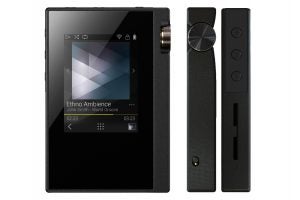
Onkyo DP-S1 – Pattern
The Onkyo DP-S1 is a neat, compact unit, which in terms of its weight and concrete dimensions brings back memories of the audio cassettes of my babyhood – you know, those counterpart tapes that could store a whole album on each side.
Non surprisingly, build quality is far more than impressive and the obsidian-like fascia is nicely offset by the sturdy pumice-like frame and leatherette rear panel.
1 of Onkyo'south main rivals is Astell&Kern, which has been at the forefront of audiophile DAP (digital audio thespian) operation for some fourth dimension. Its portable players are literally at the cutting-edge of design in that they can slash a suit pocket to shreds in no fourth dimension. Happily, the edges of the Onkyo DP-S1 await sharp simply closer inspection reveals they're slightly softened so the player is perfectly comfy to agree.
Within the fascia is a 2.4-inch touchscreen, with all other exterior controls dispersed around the narrow sides. These comprise the nicely milled volume control dial (a design that's replicated past various manufacturers these days), on/off button, send controls (play/intermission, skip, rewind), micro-USB slot, dual microSD card slots (max 200GB each), a lock switch and ability push.
The volume control feels loose and tin continue rotating even after the volume has reached its maximum, which is annoying if you want to crank it up without looking at the screen. On the plus side, the on-screen adjustment is nicely responsive to the move of the punch, and the setting can be locked with the aforementioned slider switch.
Equally well every bit a common or garden three.5mm headphone socket (which is gilded-plated), at that place's also a 2.5mm balanced output for use with compatible headphones. Balanced headphones are very much in the realm of audiophiles, but the two.5mm balanced output is starting to characteristic regularly on mid-range players such as the Astell&Kern AK70 Mk II and Sony ZX300.
The DP-S1 can't be used as an external DAC, but both headphone outputs can be configured as a line-out for use with an external amplifier, such as in a car. Not a fan of wires? You can stream from the unit of measurement to a Bluetooth receiver, although you'll have to settle for the bog-standard SBC codec rather than the superior aptX.
Related: Best headphones
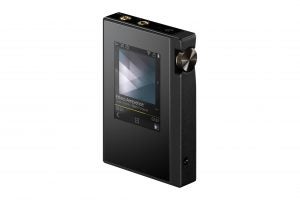
Onkyo DP-S1 – Features
Although there's no Hello-Res Audio logo on the body of the player, the proper noun of the sound game is undoubtedly hi-res. In terms of format compatibility, the DP-S1 ticks every box you could expect from a sub-£400 palm-sized thespian: FLAC, DSD (v.6MHz/2.8MHz), DSD-IFF and for Apple Mac users, AIFF.
In that location'southward even support for MQA, the relatively new kid on the hello-res cake that delivers astonishingly clear and detailed sound from unexpectedly small files.
More good news is that the built-in Wi-Fi connection is a conduit to three online services, namely TuneIn radio, Deezer and, most satisfyingly, Tidal – with support for Tidal Masters, the earth'southward first Hello-Res Sound streaming service.
Under the DP-S1'due south hood is some serious sonic muscle in the shape of twin Sabre ES9018C2M digital-to-analogue converters and twin Sabre ES9601K amplifiers, capable of driving headphones from sixteen to 600 Ohms. Timing accurateness is optimised by the use of dual clocks, which can automatically detect 44.1kHz and 48kHz signals (and multiples thereof).
Similar all expert sound players, the DP-S1 likes to accept standard resolution sources and subject them to a chip of spit and polish in the shape of some sonic upsampling. On offering hither is 32-scrap upsampling to 88.2kHz, or 176.4kHz for 44.1kHz signals, and 96 kHz/192 kHz for 48kHz sources.
User adjustments include iii selectable digital filters (Abrupt, Short and Slow), and a 10-band equaliser with half dozen presets and three customisable presets.
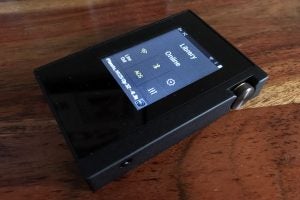
Ultimately, the DP-S1 is judged on its sound performance and capabilities, only in terms of ease of use it comes upwardly a little brusk.
The external buttons are fine, but compared with my iPhone 7 the DP-S1's 320 x 240-pixel TFT LCD screen is a small and sluggish mistiness. The homescreen looks reasonable: a sensibly laid out grid providing admission to Wi-Fi, Bluetooth, settings, line out, balanced output and the equaliser, plus the music library and online source.
As interfaces get, it's dullsville all the way – white or yellow text on a grayness background – merely even less impressive is text'southward lack of sharpness (caused by the screen's depression pixel density) and, where album art is bachelor, mushy-looking images. At to the lowest degree the player is quick to boot up from a standing start.
Enter the library and you find a long listing of shortcuts to folders (internal or external storage), albums, artists, playlists, songs and genres. You can click into each shortcut and scroll through each listing.
The lack of a search function is annoying, everything is listed alphabetically, but you tin can at least get back step-by-pace through the menu or quickly arrive at the homescreen by pressing a small-scale grid icon that appears on every screen.
When a song is playing, its title, artist name and album name appear below the anthology art, plus in that location's a tiny progress bar. A 2d screen allows quick access to the EQ adjuster, output way (line/headphone), repeat/shuffle options and handy 'Add together to playlist' option.
Utilize the homescreen to make Wi-Fi network connections (entering passwords is somewhat laborious simply only needs doing once) and pair Bluetooth devices. At that place's an Audio menu for adjusting the gain, limiting the volume and switching the USB socket to output DSD (as DoP) for use with an external DAC.
Other handy features include adjustments for the brandish time-out setting and auto ability off (off, 10, xxx, 60 minutes) in instance you forget to do and so manually. With minimal screen interaction yous tin can look to get around fifteen hours of use at reasonable volume level, which is pretty decent really.
Overall, it's a case of 'could do improve' when information technology comes to the UI, with nigh no comfort to be taken from the fact that Onkyo has a smartphone app that replicates all of the menu'due south features without actually managing to make the experience any better.
When it comes to loading music on to the player it's a game of two operating systems – Windows and Mac Os – with Onkyo's pleasingly designed Ten-DAP software (freely downloaded from its website) only compatible with Windows.
This provides access to playlists in iTunes on the computer also every bit a shortcut to the Onkyo Music download shop. Connect the player to your computer using a USB cable and it's a cinch to load playlists on to the DP-S1'south internal memory or SD cards.
Mac users do at least take the ability to drag and driblet from iTunes, since the player appears on the desktop every bit an external device when continued by USB. However, it'southward frustrating not to being able to view and edit playlists on the desktop.
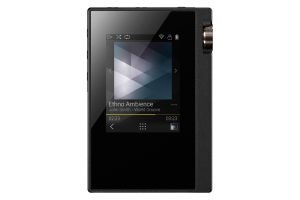
Onkyo DP-S1 – Performance
I paired the Onkyo DP-S1 with a pair of Oppo PM2 planar magnetic cans, plus some Focal in-ears that I use for listening on the go. With both headphones the DP-S1 certainly equips itself well when information technology comes to sound quality with hello-res audio files. Throughout the dynamic range it brings out item with dexterity and finesse.
I found myself totally immersed in Mahler'south 'Symphony No 5' (FLAC 24-fleck/44/1kHz), with violins floating to a higher place the wind instruments. I heard sumptuous texture in the ominous cellos, something you simply don't go on an iPhone.
Classical music is a practiced examination for any music device because y'all oft get corking variations in book. Inferior players have you reaching to plough upwardly the volume in quieter periods. This wasn't so the DP-S1, which does a cracking task of revealing detail when the dynamics are suppressed.
The player also packs a real dial with lower frequencies. The bass in Coldplay's 'Sky Total of Stars' proving squeamish and tight, with impressive extension – the perfect foil to Chris Martin'southward sonorous vocals that are arguably referencing the synth that indeed sparkles similar a star-soaked dark heaven.
Sonic imaging is splendid, with Fleetwood Mac's 'Never Going Back Over again' (24-fleck/96kHz). The initial audio-visual guitar twanging abroad wonderfully in the forefront and the quieter vocals pegged further back.
For some 192KHz MQA action I turn to Chicago's 'A Striking past Varèse', which shows just how adept the format is. It'southward a multi-layered cacophony of vocals, jazz and heavy stone. On an inferior thespian it sounds like a load of mush. Here it's a revelation, and the clarity with which each instrument appears is amazing – drumsticks, high hat, sax, bass guitar, trumpet. The whole runway is brilliantly reproduced.
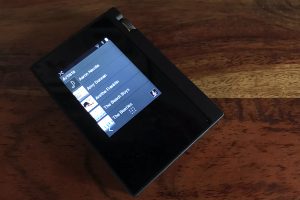
When connected to the USB input of a Revo music centre, the player acts as if it's connected to a estimator and tries to operate equally a mass storage device, making it unreadable by the Revo. Not and so easily defeated, I connected the DP-S1 to a Musical Fidelity V90-HPA headphones amp using the latter'southward asynchronous USB input. At present, both devices got on better than Trump and Putin on a Moscow night out and the amp was able to bypass the actor'south DAC.
And what a revelation, with a significant boost in gain and with it, plenty of clarity. The authentication of a proficient combination of equipment is when you can listen for ages without suffering from sonic tiredness. This is because the transparency of the sound is so pure your ears aren't forced to try to interpolate missing information. So it is here with Mahler'southward 'Symphony No five' and Holst'due south 'Planets', where I closed my eyes and it almost felt like I was just a few rows back from the stage at the Royal Festival Hall.
Playback, while not gapless, is near – as you transition from ane track to the adjacent, the gap is very brief.
The online services are a handy add-on, especially Tidal, although users of the likes of Spotify and Qobuz might demur at their absence. Annoyingly, Tidal doesn't offer offline listening, but it does support how-do-you-do-res audio with access to Tidal Masters, the gradually growing library of MQA recordings. The interface is rather tedious – all plain text, until you find and select an anthology or specific track – but the sonic quality is terrific.
For example, with 'Nightswimming' from REM's Automatic For the People, remastered and packaged as an MQA file, Michael Stipe'southward vocals and the treble piano are and then make clean and polished that it has the hairs standing up on the back of your neck. At that place'due south plenty of dynamic bandwidth then that when the lower frequency strings come up in they're textured and punchy, without cramping the vocals.
TuneIn radio, while providing access to countless global radio stations, is lamentably low in quality – Classic FM, I'g looking at you here.
Bombardment life is a claimed 15 hours, but volition more probable come in somewhat under that. I found I lost count long before the battery seemed to deplete, and am confident the player could outlive any trip between power-charging opportunities.
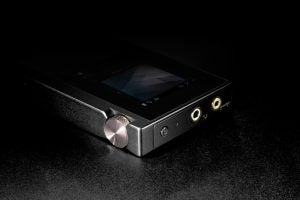
Why purchase the Onkyo DP-S1?
If you lot consider yourself to be a connoisseur of music then you're probably already aware of the benefits of owning a separate music role player. You could spend over a £1000 on a higher-cease model, simply the DP-S1 offers many of the features of players more than than twice the toll, without giving upwards besides many of the benefits.
The main compromises are that the UI is cramped, sluggish and unexciting; you can't use the histrion as an external DAC; and, if you're a Mac user, you can only drag and drop to load tracks on to the role player. There are also hidden costs in that the internal retention is a mere 16GB so yous have to buy your own micro SD cards, plus to access Tidal Masters you'll demand a top-tier subscription.
That said, the DP-S1 sounds brilliant and does sonic justice to all your hi-res audio formats including DSD, ALAC, FLAC and critically, it'due south uniform with MQA.
Rival models around the aforementioned price include the FiiO X5 3rd Gen, which has a much nicer Android-based UI and larger, more detailed screen admitting in a larger, heavier torso. The FiiO can too stream Tidal as well as Qobuz and Spotify, simply information technology doesn't support DSD files. Astell&Kern'due south AK70 Mk II, meanwhile, is a tad more expensive and offers a like overall parcel, especially at present that A&1000 has taken the original AK70 and tweaked its functioning in terms of bespeak-to-noise, crosstalk, jitter and output level cheers to the provision of a dual DAC.
Verdict
Compact and versatile, the DP-S1 delivers where information technology matters nearly –with superb hi-res audio sonics.
Trusted Score
Source: https://www.trustedreviews.com/reviews/onkyo-dp-s1